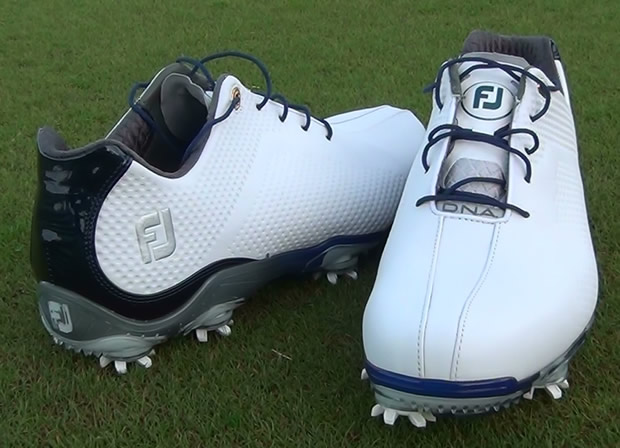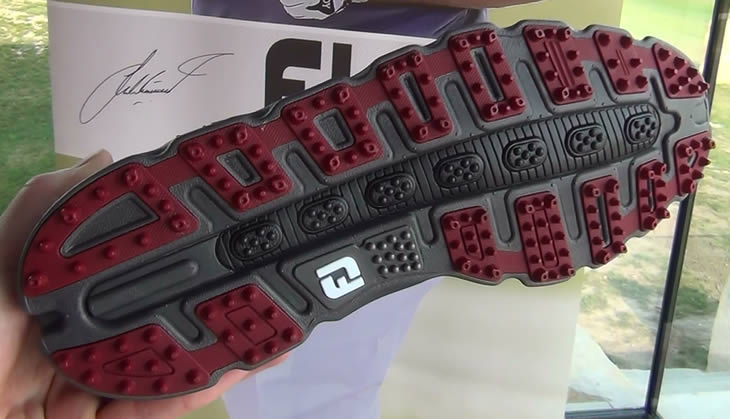FootJoy have spent a long time developing the DNA golf shoe and it features a lot of new technology for the number one golf shoe manufacturer. I met with Vice President of Golf Footwear, Doug Robinson to find out how they developed the new design.

Hi Doug. You have launched the FootJoy DNA shoe this year. What inspired you to go down this route as it is quite a sporty looking shoe compared to some of your previous models?
We have seen the change with consumers looking for athletic, more mobile, more flexible shoes and we wanted to offer that technology to them. The FootJoy DNA shoe actually started as an advanced concept about 3 years ago and was an outsole product that didn’t really have a home.
Now we have worked on thinning out the outsole and getting closer to the ground with the cushioning more inside the shoe. So where we would normally have a midsole that is outside the shoe, we have brought that inside with more technology. From there we have advanced into new technologies with the snugfit tongue, the instep and a 3D foam collar, which is really a custom fit for the inside of the shoe that hugs the back of the heel to keep you more stable.

There has been a lot of talk about lightweight in the market this year. Is there a trade off between the stability in the shoe, how it functions and the weight of the shoe?
Absolutely and we are tying to find the right balance. You can go too far so the right balance of weight, cushioning, stability, traction, waterproofing and all the things we need to build into the shoe and we do think there is a trade off. One of the areas is cushioning and as we get lighter we try to keep cushioning at a premium.
How do you measure that trade-off?
We do a lot of bio-mechanical testing where we have a firm that handles all of that for us. We test rotational traction, impact for cushioning numbers and forefoot flexibility to ensure that walking is comfortable.
Additionally we test ground reaction forces in the golf swing. What is happening to the right foot during the swing for a right handed player is very important and our testing allows us to quantify that and ensure that the products we build today are an improvement on past products and also ahead of competitor products in the marketplace.

You mention the right foot in the swing for right handed golfers. Are you at the point where you will design soles differently for right and left handed players?
We are not at that point yet, but we are looking to maximise what happens to that back foot during the golf swing by looking to transfer energy more efficiently from a technical standpoint. By quantifying it, we can look to improve it and put it into the product and DNA is a result of that.
Looking at the wider market, natural motion was a big thing recently, but that seems to have gone very quiet. Is that because it was a fad or are there other reasons?
We’ve taken some of the best parts of natural motion and we have put that into DNA, but with natural motion underfoot some things weren’t the best. Cushioning was one of those areas so when you get too thin and too close to the ground you can sacrifice cushioning and some stability. What we have tried to do with the DNA is take the mobility and deconstruct it for the upper parts. The leather is very soft and flexible to keep the mobility in the upper and allow us to beef up the cushioning, stability and traction in the outsole.
One of the other shoes you launched this year is the DryJoys Casual which is a spikeless shoe. What do you think the future is for spikeless and what percentage of golfers do you think will be wearing spikeless shoes in the next couple of years?
If I had that number I would be playing the stock market and doing very well! We don’t know. Each market is very different and we see growth in some markets still with spikeless, but growth flattening in other markets. Even within markets we see variations depending on territory, terrain and weather so it's tough to say.

We think at some point we think spikeless is going to sink to an acceptable level within each of the markets. We still think there will be demand for versatile products which golfers can wear on and off the golf course and that is not going to go away, so we will continue to develop for those players.
However with DNA, as well as with products from other manufacturers, you can see the focus is back on traction and stability and that means cleats. We understand that cleats are the best for traction which is why you see over 90% of players on the PGA and European Tours wearing cleated products.
For spikeless shoes how much research and design goes into the configuration of the sole itself?
We test those as well. DryJoys Casual had a very long development life cycle and went through the same testing process that we do with cleated products. We prototype different outsoles and they go through traction rotational testing and the results dictate which prototypes are best, so we continue developing down those lines.
Is there a percentage figure for the reduction in traction of a spikeless shoe compared to a cleated shoe?
There is probably not a percentage because there are too many variables there but the cleated product will probably just give a little extra traction out of the box. The difference though is over time. The spikeless product wears, as do all products that we walk on, but it is not renewable so the traction is reduced a little bit each time you play. That happens with cleated products also, but you can put new cleats in to refresh the traction so that gives you more long term durability and better performance over time.